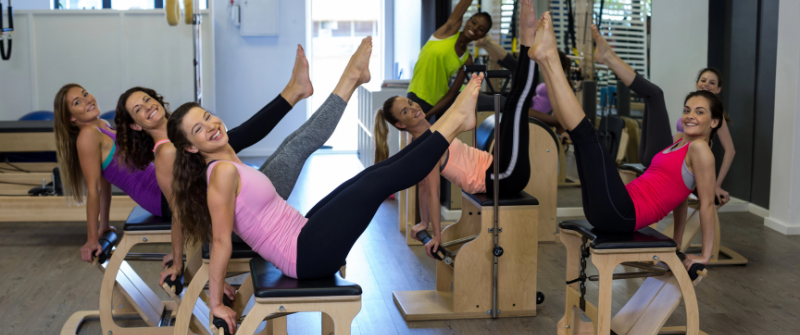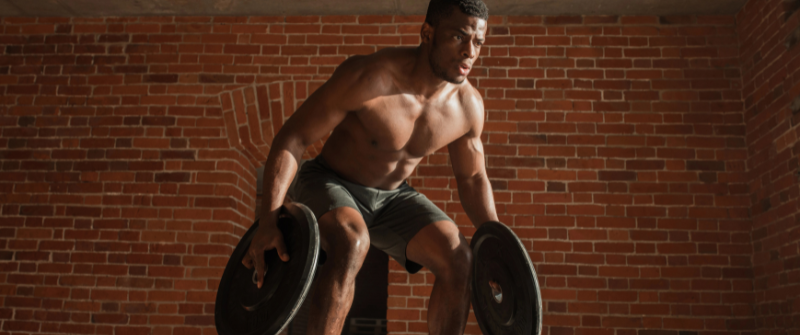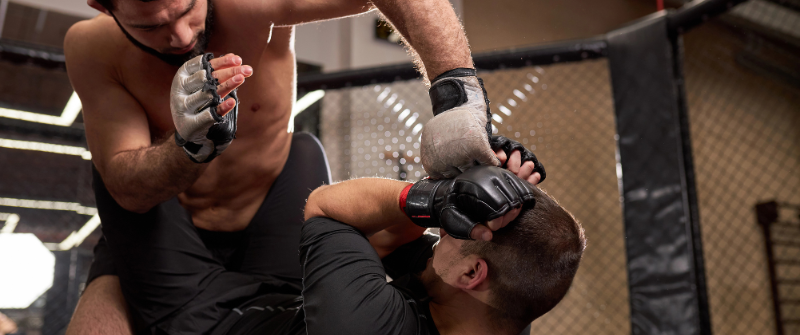
- by NEXO Team
- July 26, 2024
The intensity and athleticism associated with Mixed Martial Arts (MMA) have caused the sport to experience a surge in popularity, which has increased the demand for well-equipped training facilities. An MMA gym needs to be outfitted with the right equipment in order to provide effective training, attract clients, and keep everyone at the gym safe. Along with selecting the right equipment, securing comprehensive martial arts studio insurance is also important for protecting your investments and creating a safe training environment.
In this article, we’ll outline the equipment that’s needed to start and run a successful MMA gym.
Essential Training Areas and Equipment
General Gym Setup
When most people think of MMA equipment, items like heavy bags and kicking shields typically come to mind. While these are essential pieces for an MMA gym to have, it’s just as important to consider all of the aspects of the general gym setup:
- Training Zones: Gym owners should allocate ample space for different zones to accommodate all of the aspects of MMA training.
- Flooring: Invest in high-quality flooring, and use padded mats and shock-absorbent surfaces to cushion falls and reduce impact on members’ joints.
- Air Circulation and Lighting: Ensure proper air circulation in the gym to maintain comfortable temperatures and install bright lighting throughout to enhance visibility.
Alongside these measures, having professional & general liability insurance protects the gym against potential accidents or injuries.
Striking Equipment
After the gym setup is in place, it’s time to secure striking equipment. This includes:
- Heavy Bags: MMA gym owners should invest in various types and sizes of heavy bags, as these enable students to practice punches, kicks and strikes.
- Speed Bags and Double-End Bags: When used in exercises, these help students improve their hand-eye coordination, speed, and reflexes.
- Mitts and Thai Pads: These are essential for practicing precision and power striking.
- Kicking Shields: Kicking shields are larger, thicker pads that are helpful for practicing powerful kicks and knee strikes.
- Wall-Mounted Bags: These are great for precision striking practice, as they act as stable targets that don’t move.
Before purchasing the equipment outlined above, make sure your martial arts studio insurance covers all striking equipment to avoid any unexpected liabilities.
Grappling Equipment
Grappling is a fundamental part of MMA training, so equipping the gym with the right tools for ground-based training is key. MMA gym owners should invest in the following grappling equipment:
- High-Quality, Non-Slip Mats: Investing in mats is crucial, as is making sure your Professional & General Liability Insurance includes coverage for grappling equipment. Look for durable, easy-to-clean mats that provide adequate cushioning and grip to prevent injuries.
- Grappling Dummies: These tools are invaluable when it comes to practicing throws, submissions, and ground control techniques.
- Crash Mats: These are thicker, softer mats that are helpful for practicing high-impact throws and takedowns with reduced injury risk, as they provide extra cushioning for techniques that involve lifting and dropping opponents.
Strength and Conditioning Equipment
A well-rounded MMA training program incorporates strength and conditioning so fighters are able to improve their overall performance and endurance. When incorporating this equipment, first confirm that it’s covered under your martial arts studio insurance policy. Here’s the strength and conditioning equipment that all MMA gyms should have:
- Free Weights, Kettlebells, Resistance Bands, and Medicine Balls: These are versatile strength training tools that allow fighters to build muscle.
- Treadmills, Stationary Bikes, Rowing Machines, and Jump Ropes: These are used to improve cardiovascular fitness and help fighters improve their stamina and endurance.
- Battle Ropes, Sandbags, and Plyometric Boxes: Members should use these pieces for developing explosive power and muscular endurance.
- Cones, Ladders, and Hurdles: These are agility tools that are helpful for improving footwork, speed, and coordination.
Specialized Equipment for MMA Training
Cage or Ring
To create an authentic training environment and prepare fighters for their competitions, MMA gyms need specialized equipment. Two key components are cages and rings:
- Cage or Octagon: An MMA cage, typically 20-30 feet in diameter, simulates real fight conditions. It allows members to practice cage work while helping them develop spatial awareness. Before installing a cage or octagon, gym owners should also thoroughly review their Professional & General Liability insurance to cover any incidents during high-intensity training sessions.
- Boxing Ring: Including a traditional boxing ring provides members with a dedicated space for boxing and striking practice.
Sparring and Protective Gear
Keeping members of the MMA gym safe during their training sessions is imperative, and doing this requires several types of protective equipment. Every MMA gym should have:
- Gloves: Having a variety of gloves available allows members to train effectively for different aspects of MMA while protecting their hands and training partners.
- Headgear and Mouthguards: These help protect a person’s head and teeth during sparring sessions. Quality headgear reduces the risk of cuts and concussions, and mouthguards help prevent dental injuries.
- Shin Guards and Protective Cups: Shin Guards are essential for safely practicing kicks during sparring, and cups protect against accidental strikes to the groin.
- Hand Wraps: These provide wrist and knuckle support during heavy bag work and sparring sessions.
Brazilian Jiu-Jitsu and Wrestling Gear
Both Brazilian Jiu-Jitsu and wrestling are integral parts of MMA, and in order to have safe and effective training, they require specific gear:
- Gi and No-Gi Training Gear: Provide both traditional BJJ for gis for gi training and rash guards and grappling shorts for no-gi sessions. Having a variety of gear allows members to train in different styles and prepares them for different grappling scenarios in MMA.
- Specialized Mats and Padded Walls: Install high-quality, thick mats that are designed for safe takedowns and groundwork.
- Ankle and Knee Supports: MMA gyms should stock a variety of ankle and knee braces to offer additional joint protection during intensive grappling sessions.
Facility and Member Amenities
Locker Rooms and Showers
It’s important to provide members with comfortable and hygienic facilities so they’re able to prepare for and wind down after their training sessions. While providing locker rooms and showers is essential, so is having Professional & General Liability Insurance to cover these amenities. A well-designed locker room and shower area should have these components:
- Secure Storage: Install sturdy lockers so members can store their personal items, clothing, and equipment safely during training sessions.
- Clean and Spacious Shower Facilities: Offer well-maintained shower areas. Having multiple shower stalls with proper drainage and non-slip flooring helps members stay safe and comfortable while they clean up after their workouts.
Reception and Lounge Areas
Creating welcoming spaces for members to unwind is important when it comes to building a strong gym community. Some areas to consider are:
- Reception: Design an inviting reception area, as this is the first point of contact for members and visitors. This space should include a desk for staff to manage check-ins and answer questions, along with displays offering information about the gym.
- Lounge Area: Designate a comfortable space for members to relax before or after their workouts.
Pro-Shop and Retail Space
A well-stocked pro shop is a convenient way for members to secure gear and supplies for their sessions while also acting as an additional revenue stream for the gym. Retail spaces should include:
- Training Gear: Offer a selection of MMA equipment, such as gloves, hand wraps, mouth guards, and apparel.
- Nutrition Products: Stock protein powders, hydration products, and healthy snacks to support members’ nutritional needs before and after their workouts.
- Branded Merchandise: Create and sell gym-branded items like t-shirts, hoodies, and water bottles to generate additional income while promoting gym loyalty.
Office and Administration Space
Any successful MMA gym needs efficient management. Here’s how to set up your administrative areas:
- Office Space: Designate a private space for gym operations and administrative tasks.
- Customer Service Area: Create a space for handling memberships, billing, and customer inquiries.
Technology and Multimedia Tools
Audio-Visual Equipment
Enhancing the training environment with the right audio-visual setup will improve members’ overall experience. Here’s what equipment to consider:
- Sound System: Install a high-quality audio system throughout the gym for playing motivational, upbeat music and making clear announcements.
- Video Monitors and Projectors: Place video video monitors or projectors throughout the gym to display instructional videos, technique demonstrations, and live event streams.
Training and Performance Tracking
Incorporating technology enhances the effectiveness of the training sessions, so it’s worth investing in the following components:
- Digital Scoring Systems: Implement digital scoring systems for tracking sparring sessions and competitions.
- Wearable Technology: Offer or encourage the use of wearable devices for tracking heart rate, calories burned, and other performance metrics during training.
Member Management Software
MMA gyms need to efficiently manage their gym operations in order to be successful. Here’s how technology helps streamline these processes:
- Scheduling and Booking Systems: Implement software that lets members easily view class schedules and book sessions online.
- Billing and Payment Processing: Utilize integrated systems to manage memberships and process payments securely.
- Member Communication Platforms: Adopt tools to maintain consistency.
Communications with members via email, text messages, or dedicated apps.
Safety and Maintenance Equipment
Cleaning and Sanitation Supplies
Keeping the gym clean and hygienic is imperative for the health and safety of members and staff. Here’s what MMA gym owners should prioritize when it comes to cleaning and sanitation:
- Disinfectants and Cleaning Tools: Stock a variety of disinfectants, microfiber cloths, mops, and other cleaning tools to maintain hygiene.
- Hand Sanitizer: Install hand sanitizer dispensers throughout the gym, including near entrances, exits, and any high-traffic areas.
First Aid and Emergency Equipment
Practicing MMA may result in injuries, so it’s incredibly important to prioritize members’ safety with the following equipment:
- First Aid Kits: Place well-stocked first aid kits in easily accessible locations throughout the gym.
- AEDs and Fire Extinguishers: Install Automated External Defibrillators (AEDs) in visible areas and make sure all staff are trained in how to use them. Fire extinguishers should also be placed throughout the facility, especially near electrical equipment and in places where they may be needed quickly.
Along with the equipment outlined above, it’s also crucial to have a robust martial arts studio insurance policy to address any emergencies.
Regular Maintenance Supplies
 Keeping equipment in optimal condition is important for the gym’s safety and longevity. Gym owners should invest in the following for regular maintenance:
Keeping equipment in optimal condition is important for the gym’s safety and longevity. Gym owners should invest in the following for regular maintenance:
- Tools and Repair Supplies: Stock a toolbox with essentials like screwdrivers, pliers, duct tape, and spare parts specific to the gym’s equipment.
- Inspection Checklists and Tools: Create comprehensive checklists for regular safety and maintenance inspections of all gym equipment and facilities.
Budgeting and Purchasing Strategy
Estimating Costs
Starting an MMA gym requires careful financial planning. Here's how to approach budgeting for equipment:
- Initial Purchase vs. Leasing Options: Weigh the upfront costs of purchasing equipment against the long-term expenses of leasing. Buying equipment outright might require a larger initial investment but could be more cost-effective over time, while leasing provides more flexibility and lower immediate costs.
- New vs. Used Equipment: Consider a mix of new and gently used equipment to balance quality and budget.
- Bulk Purchase Discounts: Many vendors offer discounts for large orders, so look into options for buying equipment in bulk from suppliers.
Reliable Suppliers
Picking the right suppliers is important when it comes to making sure your equipment is high-quality and will stand the test of time. Here’s what to consider when selecting equipment partners:
- Equipment Suppliers’ Reputation: Research and identify trusted suppliers who are known for quality equipment. Look for vendors with positive reviews from other gym owners and specific experience in working with MMA facilities.
- Service and Warranty Considerations: Prioritize suppliers who offer comprehensive warranties and after-sale service for equipment.
Conclusion
Obtaining the right equipment is a requirement for starting any successful fitness facility, and MMA gyms are no exception. Each piece of equipment outlined above plays an important role in creating a safe training environment for members, which puts the gym in an excellent position to attract and retain dedicated MMA fighters.
Remember that protecting your investment is just as important as the equipment that you choose. At NEXO, we’re here to provide you with affordable, comprehensive martial arts studio insurance. Contact us to learn more.
Categories
Fill out a short form to contact us with your questions or to receive a customized quote.
Recent Posts
-
 Why Jiu-Jitsu Schools Face Higher Liability Than Other Gyms and How to Manage It
January 5, 2026
Why Jiu-Jitsu Schools Face Higher Liability Than Other Gyms and How to Manage It
January 5, 2026 -
 Is Your Pilates Studio Prepared for a Medical Emergency?
January 5, 2026
Is Your Pilates Studio Prepared for a Medical Emergency?
January 5, 2026 -
 NEXO’s Affinity Program: How Fitness Suppliers and Associations Can Partner for Profit and Protection
December 5, 2025
NEXO’s Affinity Program: How Fitness Suppliers and Associations Can Partner for Profit and Protection
December 5, 2025 -
%20(1).png) How to Insure an MMA Gym Without Paying for Coverage You Don’t Need
December 5, 2025
How to Insure an MMA Gym Without Paying for Coverage You Don’t Need
December 5, 2025 -
 Mastering Liability for Jiu-Jitsu Tournaments and Martial Arts Events
December 5, 2025
Mastering Liability for Jiu-Jitsu Tournaments and Martial Arts Events
December 5, 2025

